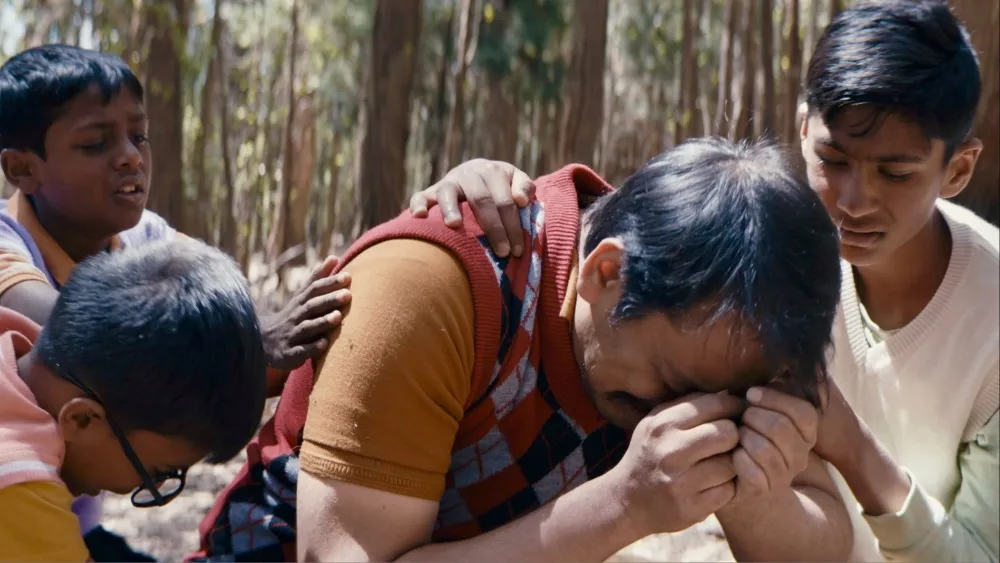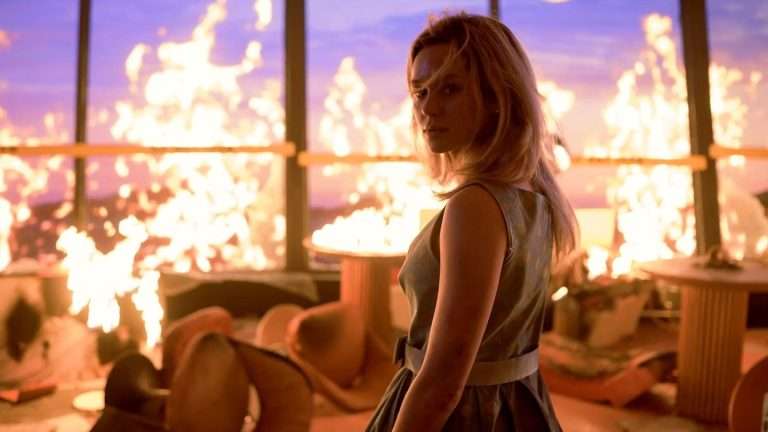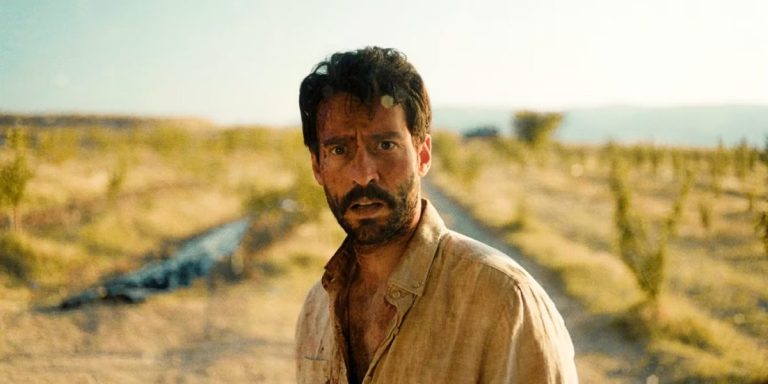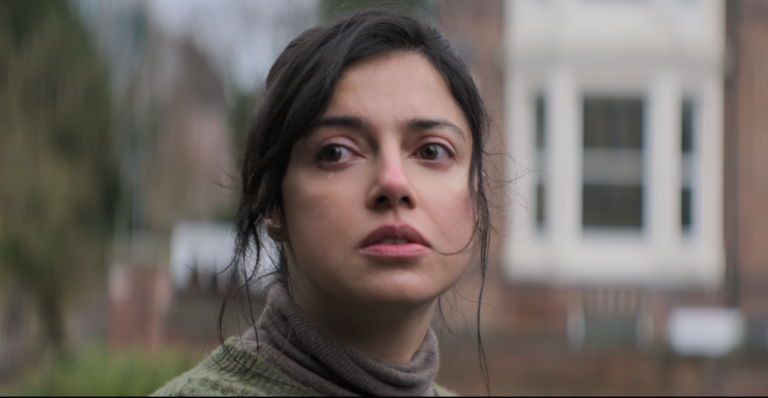Naangal (2024) “IFFR” Movie Review: If we could travel back in time and relive the most secure and joyful location we’ve ever been, it would most likely be our home. There, we’ve experienced the full range of human emotions, from fleeting moments of happiness and contentment to more profound moments of sadness and loss.
It mostly circles around our family, where memories are stored, and ties are created. Unfortunately, not everyone’s past has been rosy. Some may have had more hardship than triumph. Avinash Prakash portrays such a subject in his gripping and emotionally charged film, “Naangal.”
The film focuses on three boys and a father living in a cozy, cold hillside village. There’s Karthik, the eldest son, followed by a set of non-identical twins, Gautham and Dhruv. In the beginning, we observe the children enjoying a carefree day out, discovering all the joy the village offers.
Their smiles reveal their delight, which leads us to believe that it is something they’ve been longing for. However, we gradually witness the setbacks that happen once they’re back home, where everyone starts to fret over small things.
There seems to be no electricity or water in the house, while the kids use oil lamps and barrels of water that they have filled themselves. We get the impression that these young individuals are self-sufficient in handling household tasks and responsibilities, much like in the film “Nobody Knows” by Hirokaazu Koreeda. The good vibes that were making us smile go out the window the moment their dad gets home, where misery hits like a wave for everyone.
The children’s perspectives are prevalent throughout the film, but the father’s tyrannical depiction is where the crux of the story resides. Viewers are exposed to an authoritarian who uses the power that lies in his hands to intimidate his kids continuously.
He is abundantly strict and instills the worst masculine traits to induce fear in his kids. It is reasonable to assume that his position as chair and principal of a public school compels him to demonstrate his leadership abilities in a more stringent way.
On the other hand, the children suffer since the dominating conduct is accompanied by extreme fury and aggression. Some instances of such prohibitions include not letting the kids play with their loyal dog, Kathy, or watching movies at the theater and expecting them to keep the house spotless. With meticulous attention to detail, filmmaker Avinash allows the viewers to observe these unsightly events that are horrifying at most.
Both the children’s and the father’s mental health decline is another vital theme the film explores. Child abuse manifests itself in many forms, including psychological and physical assault. The crippling anxiety brought on by the pent-up terror has taken an emotional toll on the children.
Karthik’s immediate response of apologizing after being asked by his father for his shoe is a perfect example. The constant struggle of not knowing when the next abuse will manifest seems like a ticking bomb for these kids.
The father, meantime, is struggling with mounting depression as a result of relationship problems and financial constraints. In a classic example of corporal punishment, he takes in the stress and projects it onto his children through alcohol and physical violence. His estranged wife, Padma, also leaves the family, which points to the father’s non-compatibility issues and misogyny. Here, viewers can witness how one individual with acute depression and narcissism can disrupt a healthy family structure.

Avinash subtly depicts the value of family ties, especially in the face of adversity. As the firstborn, Karthik bears the weight of responsibility while his twin siblings figure out how to get by on a daily basis. The children may have unique passions and interests, but they also have a tendency to respond in the same manner to any kind of distress. They stick together through thick and thin, no matter how much agony they withhold on the inside.
In a new light, we see how a visit strengthens their relationship with their mum and grandparents. This is the segment that exposes the missing piece that the kids were longing for – attachment. The development of bonds among family members is exquisitely observed.
But when challenges come knocking on the mother’s family door, the distance that has left a void in the family starts to show. In the process, numerous polarizing views are gathered on the core elements of the film. Perhaps the ‘90s was a phase of time where mental health issues were not seen as an important element to work on.
On the other hand, might it be that certain people in a very regimented work atmosphere are just that way with everyone, even their own families? Does a parent’s absence further destabilize a normally functioning family unit? Could a negative trait of a parent be handed down to their kids despite enforcing intense discipline in their upbringing?
Is strict parenting a justifiable way of showing discipline to kids? Does self-confidence necessitate burying feelings of empathy and closeness with loved ones? Does the lack of trust and optimism in the children just rest on the father? Filmmaker Avinash clumps all these intriguing questions and leaves it for the audience to decide.
Another notable aspect of the film is cinematography. In order to convey the range of human emotions, filmmaker and cinematographer Avinash Prakash uses color as a medium of information exchange. In the film, scenes depicting acute moments of terror and despair are shown in black and white, while scenes depicting happiness and courage are primarily colored.
Abdul Rafe’s portrayal of the father, with his sudden outbursts of fury and insightful philosophical quotations, is quite commendable. However, the film truly comes to life due to the magnetic chemistry displayed by the young actors, which makes one question whether they are related.
While watching the movie, one can truly appreciate the rich tapestry of Indian languages. Conversations are primarily in Tamil and English, with a touch of Malayalam thrown in. The film also features a Hindi song that the father greatly admires.
All things considered, “Naangal” is undeniably a personal film that clings to memories and reflects all that comes along with them. The film showcases the best of both worlds – the jubilant moments and the struggles to cope with a difficult situation. The best analogy would be a flowering rose among a bush of sharp thorns.
With a runtime of 259 minutes, the film courageously exposes audiences to a complex and honest depiction of familial connections and childhood misery. Whether it’s a spontaneous dance party in the kitchen, a thrilling comic book reading session, or a wild outburst in the midst of a forest, memories are what truly bring a person to life.
Perhaps filmmaker Avinash is the alter ego version of Lav Diaz to shift the focus towards the inner politics of families instead of the country. Nevertheless, as suggested by the IFFR to showcase the film under the “Bright Future” category this year, filmmaker Avinash Prakash has definitely marked his territory as an esteemed director to be looked upon.


![Room 203 [2022] Review: A Gripping Tale that Ebbs and Flows between being a Teenage Drama and a Thrilling Horror Movie](https://79468c92.delivery.rocketcdn.me/wp-content/uploads/2022/04/ROOM_203-1-768x341.jpg)
![The Dark and the Wicked [2020] Review: Cosmic Evil in Lonesome Americana](https://79468c92.delivery.rocketcdn.me/wp-content/uploads/2020/11/The-Dark-and-the-Wicked-768x431.jpg)

![Madres [2021] Review: A Half-baked Political Horror Film that Misses more than it Hits](https://79468c92.delivery.rocketcdn.me/wp-content/uploads/2021/10/Madres-2021-Movie-Review-3-768x432.jpg)

